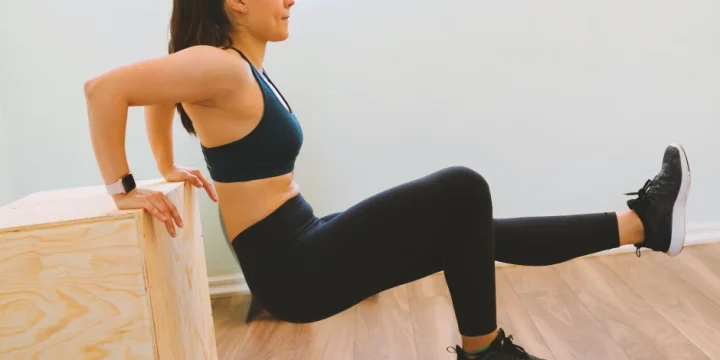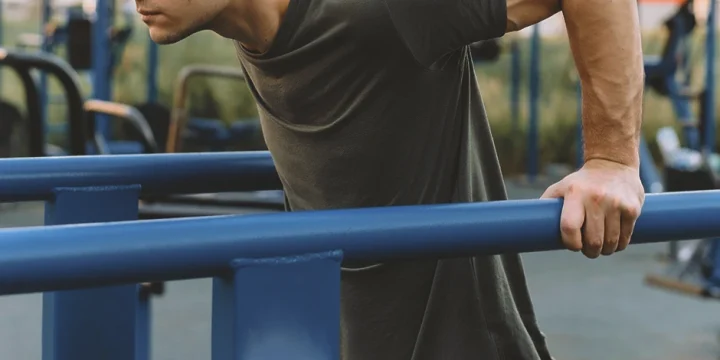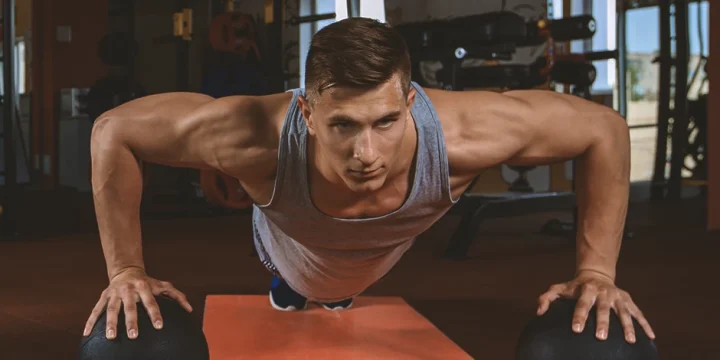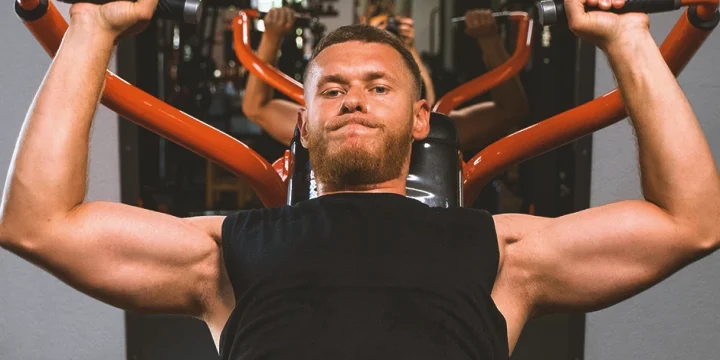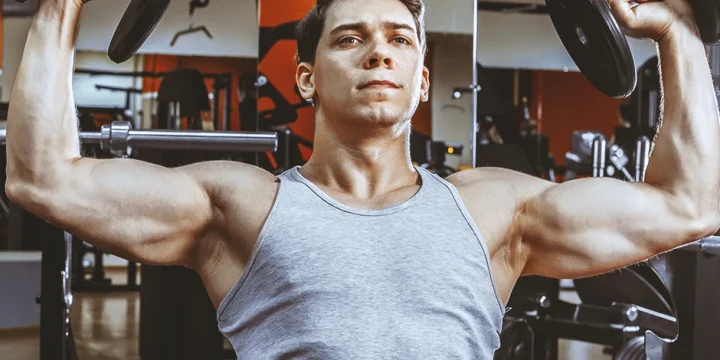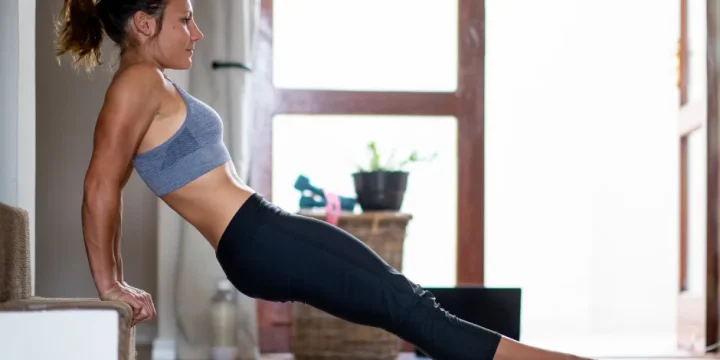Chest dips are great for targeting the pectoral muscles, triceps, and deltoids.
The exercise is simple. However, certain people may not have the upper body strength required to bear their whole body weight.
As a result, they may prefer other workouts that target the same muscles to improve strength and growth in the chest, arms, and shoulders.
For strength and gains, get enough rest, eat healthily, and replenish your energy levels using these best post-workout drinks.
As a certified fitness trainer with over six years of experience, I will provide my expertise and findings on the best chest dip alternative exercises you can include in your training regimen, the muscles worked by these workouts, and their benefits.
Quick Summary
- The best chest dips alternative exercises are the close grip bench press, decline bench press, floor chest press, bench dips, neutral grip dumbbell press, diamond push-ups, and chaos push-ups.
- Chest dip alternative exercises will help you if you want to gain more upper body power, whether you wish to develop mass and shape your muscles or boost your general power.
- According to the National Institutes of Health, strengthening the chest muscles can help shape them and enhance forward arm rotation.
- From my perspective as a fitness coach, diversifying with chest dip alternatives is key to achieving balanced upper body development.
The Chest Dip Alternatives

Close Grip Bench Press
The close grip bench press, with hands shoulder-width apart, shifts the load from the chest to the triceps.
This adjustment, often used in my coaching, reduces the weight lifted but maintains efficiency due to targeted muscle engagement.
Additionally, this grip lessens strain on the shoulder joint.
"The close grip bench press is an excellent activity to incorporate into your push and upper body routines for increased muscular hypertrophy and strength. Make use of a bench station or a flat bench/power rack combo."
- Shana Verstegen, American Council on Exercise (ACE) Certified Personal Trainer
How to perform:
- Place the barbell on the rack at the appropriate reach level (you ought to be able to grip the barbell off the rack with help).
- Load weight resistance onto the barbell per your fitness level.
- Lie on the flat bench and place both hands shoulder-width apart on the barbell.
- Lift the barbell with the rack's aid, arms locked, and raise the bar straight over your head.
- Inhale and steadily lower the barbell to the chest, maintaining your elbows tight to your torso during the exercise.
- Exhale and use your triceps to drive the bar up to the starting position, locking your arms at the peak of the exercise.
- Repeat for the desired number of reps.
Decline Bench Press
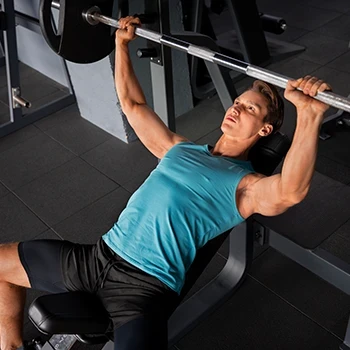
The decline bench press is a version of the bench press that is designed to focus the chest muscles.
It will also effectively target the triceps and shoulder muscles.
How to perform:
- Lie on a decline bench with both your feet hooked underneath the pad.
- Pinch the shoulder blades together and drive them into the bench to position them.
- Breathe deeply and allow the spotter to assist you with the lift-off to keep your upper back taut.
- Allow the weight to settle, and keep your upper back tight after lifting off.
- Inhale and slowly lower the bar by freeing the elbows.
- Lower the bar to just below the sternum (breastbone) and contact your chest.
- Press yourself into the decline bench and stretch your elbows to raise the barbell to the starting position in a straight line.
- Repeat for reps.
Learn more: What Muscles Does The Bench Press Work
Floor Chest Press
The floor chest and bench press work the same muscles, including the chest, shoulders, and triceps.
You cannot lift as much load as you would with the barbell bench press, but you may still load up the bar and experience upper-body power gains.
How to perform:
- Lie on the ground and hold the bar with an overhand grip with both hands shoulder-width apart. Your feet can be stretched or bent with your legs grounded.
- Unrack the bar and hold it above you if you're lying under a rack, but if you're lying under a grounded bar, you may need to find someone to assist you in lifting it at the beginning of a set, especially if you're using large weights.
- Once you're grasping the bar above the chest with both arms outstretched, gradually lower it until the upper arms contact the ground.
- Press the bar back up explosively to the starting position.
- Repeat for the desired number of reps.
Bench Dips
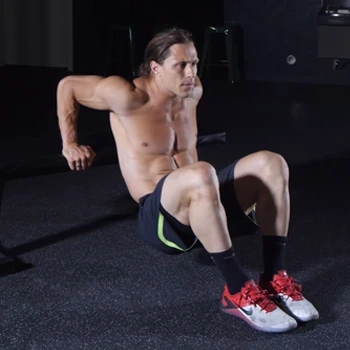
The bench dip is an excellent bodyweight exercise for targeting the arms. It applies to everybody, regardless of fitness level, and strengthens arms.
The workout also targets and strengthens the muscles in your chest and shoulders.
How to perform:
- Set up for the bench dip by positioning two flat benches parallel to one another about 4-5 feet apart (the width may need to be adjusted to accommodate your height).
- Place your heels about shoulder-width apart on the tip of one bench.
- Place both hands on the opposite bench's edge. This is the workout's starting position.
- Slowly lower your body, maintaining your torso close to the bench until your elbows reach the same level as your shoulders.
- Squeeze the triceps as you slowly push back up.
- At the peak of the exercise, don't lock the elbows out.
- Repeat for the desired number of reps.
Neutral Grip Dumbbell Press
The dumbbell bench press does not enable you to go as heavy as the barbell bench press, but it does allow you to modify your grip to focus more on your triceps.
While hitting the chest and triceps, grab the dumbbells in a neutral grip slightly broader than shoulder level.
If one of your sides is weaker, the unilateral nature of the dumbbell allows that side to catch up to the other.
How to perform:
- Sit on a bench and hinge forward to take up each dumbbell.
- Place each weight on a knee, lean back, and then push the dumbbells towards you with your knees.
- With your hands facing each other, press the dumbbells above your chest. This is your starting point.
- Then, while maintaining your elbows tucked in, descend the dumbbells until the elbows break 90 degrees.
- Push the dumbbells back up to the starting position until they lock out, then reset.
- Repeat for the desired number of reps.
Also read: How to Do Banded Dumbbell Bench Press
Diamond Push-ups
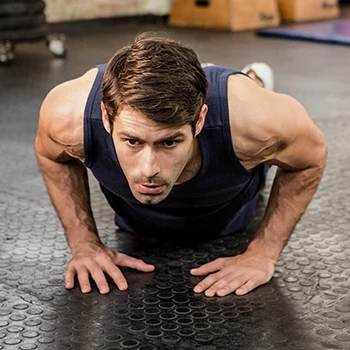
A diamond push-up is an advanced form of standard push-ups that work different muscle groups by altering body positions.
They are bodyweight exercises that can be done practically anywhere.
How to perform:
- Get on all fours and put both hands together beneath your sternum.
- Make a diamond shape with the thumbs and index fingers by touching them together.
- Extend your hands so your body is lifted, and a straight line runs from the head to your legs.
- Lower your torso towards your hands, keeping your back flat and your elbows from flaring to the sides.
- Stop right before your chest meets the floor.
- Press up to return to the beginning position.
- Repeat for the desired number of reps.
"Athletes can use diamond push-ups to increase muscle hypertrophy, endurance, and strength. Identify your fitness objectives, and then change the variety and rep range accordingly."
- Geoffrey Blake, Athletic Truth Group (ATG) Certified Coach
Chaos Push-ups
Resistance bands are an excellent way to enhance the upper chest, shoulders, and triceps when dips are not a possibility. The chaos push-up is a perfect option.
This is accomplished by wrapping a big band around a squat rack and performing a push-up while holding the band.
How to perform:
- Wrap a strong band around two squat rack connections. The higher the resistance band, the easier it is, and the lower the band, the more difficult it is.
- Hold the band with your hands shoulder-width apart.
- Bring both legs behind you and engage your glutes and core to neutralize your spine.
- Slowly lower into a push-up position.
- Push up, reset, and then repeat for reps.
Related: Resistance Band Chest Exercises
Muscles Worked by Dips and Alternatives

Pectoralis
Both the major and minor pectoralis muscle groups are worked out during chest dips and similar workouts.
According to studies published by the National Institutes of Health, strengthening these muscles can help shape the chest and enhance forward arm rotation [1].
Levator Scapulae
The levator scapulae muscle moves from the shoulders to the neck, despite being classified as an upper back muscle.
Weakness or stiffness in this region can induce shoulder blade or neck pain and headaches, as shown by studies published by the National Library of Medicine [2].
Triceps Brachii
These muscles descend the back of the upper arm's longest bone, and exercising them can help you eliminate the "flabby arms" appearance many people have.
Aside from appearance, studies in the National Library of Medicine show that these muscles also help to stabilize the shoulders and elbows [3].
Rhomboids
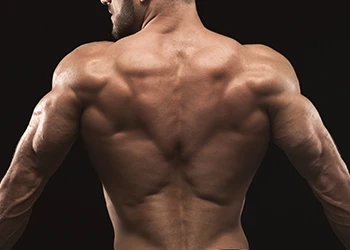
The rhomboids, positioned in the upper back, help draw the shoulder blades together and stabilize your shoulders, as per the research published by the National Institutes of Health [4].
If you get pops or soreness in your shoulders or have "knots" in your upper back, chest dips may help by focusing the rhomboids.
Latissimus Dorsi
The latissimus dorsi, one of the major back muscles, permits us to lift our shoulders away from our bodies.
It also allows us to reach overhead for items often out of our reach.
Teres Major
Another shoulder muscle group, the teres major, works with other muscles to provide a more stable range of motion in the arms.
It enables us to extend our arms when contracted; that's why dips effectively activate it.
Common Dip Mistakes

Executing dip exercises often leads to common errors, reducing their effectiveness and potentially causing injuries.
As a health and performance coach, I've seen firsthand how identifying and rectifying these mistakes is vital for injury prevention and invaluable in rehabilitation.
This approach not only enhances safety but also maximizes the exercise's benefits.
Not Maintaining the Chest Up
The chest and tricep dip are two versions of the dip that require different chest postures.
The person should lean forward further during a chest dip, whereas a tricep dip should be performed with the torso more erect.
Both types, however, will benefit from maintaining the chest up and tight so that the shoulders remain back and avoid thoracic soreness.
Related: Outer Chest Workout: Sculpt and Define
Not Going Low Enough in the Exercise
When performing a dip, the upper arms should be roughly parallel at the exercise's lowest position, with the shoulders slightly below the elbows.
Some people, however, cannot reach this stage because they stop halfway through the drop. Reduced benefits occur from not going sufficiently low into each dip repeat.
Not Locking the Elbows

Locking out the elbows protects the joints while ensuring that each repeat is completed.
Not locking out the elbows is analogous to not dropping low enough in the dip since it decreases the benefits of the workout.
Dropping Too Low in the Dip
While not going sufficiently low is a mistake when completing dips, going too low is also an issue.
When a person descends too low in the dip, the pressure on the shoulder joints might cause damage.
Thus, keeping the upper arms slightly parallel is preferable at the lowest point of the activity.
Going Too Fast
Many people make the mistake of executing a workout too rapidly, as though they are rushing through an activity.
This error is frequently observed in dips, as people bounce up and down on the parallel bars.
When this happens, the mistakes mentioned are frequently made. As a result, the person is either missing out on the advantages of the activity or risking harm.
Benefits of Dips and Their Alternatives

- Improved Posture: As one of the biggest muscle groups in the upper body, the chest plays a significant part in helping good posture since its length and strength govern your shoulder position. The chest, together with the shoulder and upper back muscles, helps to support the shoulder joint.
- Improved Breathing: The length and strength of your chest muscles allow for deeper breathing via ribcage expansion and contraction. Since the chest muscle is connected to the ribcage, respiration may be impaired if it is tight or short.
- Improved Sports Performance: Any sport that demands you to strike a ball, draw off an opponent, throw a ball hard and quickly, or tackle a competitor to the ground necessitates the development of chest and triceps endurance and strength.
- Improved Lockout Strength: Most pressing workout variants, such as shoulder presses, depend on the triceps to stretch and lock out the arm. With pressing workouts, there comes a time when it is less about the chest and shoulders and more about the triceps. And if the triceps are weak, your gains will suffer.
- Improved Shoulder Health: The triceps and chest muscles, which link to your scapula and shoulder joint, help with shoulder strength, mobility, stability, and health. They will influence your shoulder movement and health if they are weak, tight, or short.
Related posts:
FAQs
Are Chest Dips Necessary?
Yes, chest dips are necessary. Chest dips are an effective way to develop the chest muscles. If you reach a plateau, you can place a weighted vest or a dumbbell between your legs to enhance the difficulty level.
Do Dips Make the Chest Bigger?
Yes, dips make the chest bigger. Dips are excellent for focusing the outer chest. This type of workout makes your chest appear bigger and wider.
Do Dips Increase Mass?
Yes, dips increase mass. Dips are a complex exercise, meaning they engage many muscle groups simultaneously. This can be good for increasing muscle mass and upper-body power.
References:
- https://www.ncbi.nlm.nih.gov/books/NBK545241/
- https://www.ncbi.nlm.nih.gov/books/NBK553120/
- https://www.ncbi.nlm.nih.gov/books/NBK536996/
- https://pubmed.ncbi.nlm.nih.gov/30521277/
About The Author
You May Also Like
